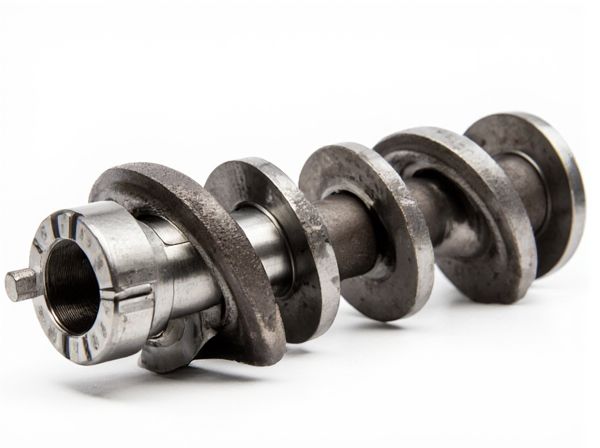
Photo illustration: Non-VVT vs VVT Camshaft
Non-VVT camshafts operate with a fixed timing, delivering consistent valve opening and closing patterns that optimize engine performance at specific RPM ranges. VVT (Variable Valve Timing) camshafts adjust valve timing dynamically to improve fuel efficiency, increase power output, and reduce emissions across different driving conditions. Choosing between non-VVT and VVT depends on your priorities for engine adaptability, fuel economy, and overall performance.
Table of Comparison
| Feature | Non-VVT Camshaft | VVT Camshaft |
|---|---|---|
| Definition | Fixed timing camshaft without adjustment. | Variable Valve Timing camshaft with adjustable valve timing. |
| Performance | Constant valve timing limits engine efficiency. | Optimizes valve timing for improved power and torque. |
| Fuel Efficiency | Lower fuel efficiency due to fixed timing. | Enhanced fuel economy by adapting valve timing to driving conditions. |
| Emissions | Higher emissions from less optimized combustion. | Reduces emissions with precise valve control. |
| Complexity | Simple design, easier maintenance. | More complex with hydraulic or electronic controls. |
| Cost | Lower manufacturing and maintenance cost. | Higher cost due to advanced technology. |
Introduction to Camshaft Technology
Camshaft technology plays a crucial role in engine performance by controlling valve timing and operation. Non-VVT camshafts have fixed profiles, resulting in consistent valve timing suitable for simpler engine designs. Variable Valve Timing (VVT) camshafts dynamically adjust valve timing based on engine speed and load, optimizing power, fuel efficiency, and emissions across different driving conditions.
Understanding Non-VVT Camshafts
Non-VVT camshafts maintain a fixed valve timing, which simplifies engine design and reduces manufacturing costs but limits performance optimization across different RPM ranges. Unlike Variable Valve Timing (VVT) systems, non-VVT camshafts deliver consistent valve lift and duration, resulting in steadier power output but lower fuel efficiency and emissions control. Understanding non-VVT camshafts highlights their reliability and ease of maintenance, making them suitable for engines prioritizing durability over adaptive performance.
Key Features of VVT Camshafts
VVT (Variable Valve Timing) camshafts dynamically adjust valve timing to optimize engine performance, fuel efficiency, and emissions under varying driving conditions, unlike Non-VVT camshafts with fixed timing. Key features of VVT camshafts include precise control of intake and exhaust valve operations through hydraulic or electronic actuators, enabling enhanced torque at low RPM and increased power at high RPM. This advanced timing flexibility improves combustion efficiency and reduces exhaust pollutants, making VVT technology essential for modern internal combustion engines.
Performance Differences: Non-VVT vs. VVT
Non-VVT camshafts provide fixed valve timing, resulting in consistent but less adaptable engine performance, especially at varying RPMs. VVT camshafts optimize valve timing dynamically, improving power output, fuel efficiency, and emissions by adjusting to engine speed and load conditions. This adaptability enables VVT engines to deliver better acceleration, smoother idle, and enhanced overall performance compared to non-VVT counterparts.
Fuel Efficiency Comparison
Non-VVT camshafts have a fixed valve timing that limits engine breathing efficiency under varying loads, often resulting in less optimal fuel consumption. VVT camshafts dynamically adjust valve timing based on engine speed and load, enhancing combustion efficiency and reducing fuel consumption by optimizing airflow and fuel mixture. Studies indicate vehicles equipped with VVT technology achieve fuel economy improvements ranging from 5% to 15% compared to non-VVT engines.
Impact on Engine Emissions
Non-VVT camshafts operate with fixed valve timing, resulting in less precise control over fuel combustion and higher exhaust emissions due to incomplete fuel burning. VVT camshafts dynamically adjust valve timing based on engine speed and load, optimizing air-fuel mixture and improving combustion efficiency, which significantly reduces harmful emissions like NOx, CO, and hydrocarbons. Studies show vehicles equipped with VVT technology emit up to 30% fewer pollutants compared to those with non-variable systems, contributing to cleaner air and compliance with stringent emission standards.
Maintenance and Longevity
Non-VVT camshafts generally require less maintenance due to their simpler design but may lead to reduced engine efficiency and performance over time. VVT camshafts, equipped with variable valve timing systems, demand more regular inspection and oil quality monitoring to ensure the hydraulic actuators operate smoothly, significantly enhancing engine longevity and fuel economy. Proper maintenance of VVT systems extends engine life by optimizing valve timing, reducing wear, and preventing costly repairs associated with timing chain or actuator failures.
Cost Considerations
Non-VVT camshafts typically have lower production and maintenance costs due to their simpler design without variable timing mechanisms, making them more affordable for budget-conscious buyers. VVT camshafts, incorporating advanced technology to optimize valve timing for performance and fuel efficiency, involve higher manufacturing costs and potentially increased repair expenses. When considering cost, the initial savings of Non-VVT systems must be balanced against the long-term fuel economy and power benefits provided by VVT-equipped engines.
Suitability for Specific Engine Applications
Non-VVT camshafts offer fixed valve timing, providing consistent performance ideal for simpler engines where cost-effectiveness and reliability are priorities. VVT camshafts adjust valve timing dynamically, enhancing fuel efficiency, power output, and emissions control, making them well-suited for modern engines requiring variable operating conditions. Engine designs focused on performance versatility and environmental compliance benefit most from VVT technology, while basic or older engine models often utilize non-VVT camshafts.
Future Trends in Camshaft Technology
Future trends in camshaft technology emphasize the shift from traditional Non-VVT (Variable Valve Timing) camshafts to advanced VVT systems, enhancing engine efficiency and performance by dynamically adjusting valve timing. Emerging innovations include continuously variable cam profiles, electro-hydraulic actuators, and integration with hybrid powertrains to optimize fuel economy and reduce emissions. The adoption of AI-driven control algorithms and lightweight materials is set to redefine camshaft functionality, promoting smarter, more adaptive engine management in next-generation vehicles.
 caratoz.com
caratoz.com